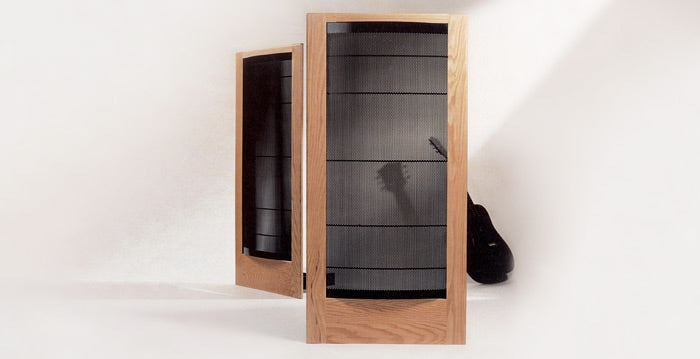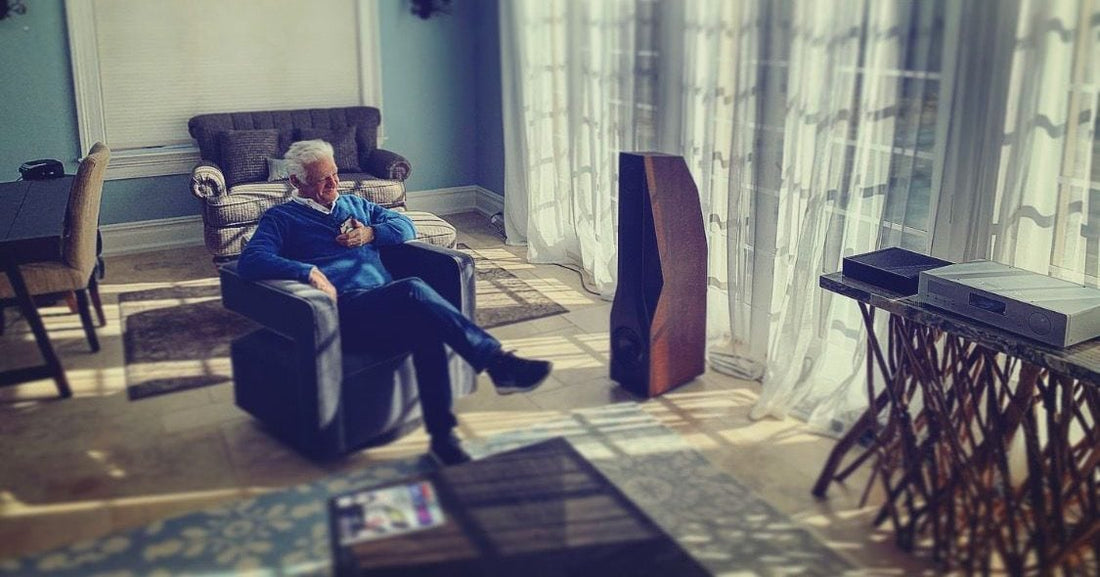Gayle Martin Sanders was one of the co-founders of electrostatic loudspeaker manufacturer MartinLogan, along with Ronald Logan Sutherland. (They combined their middle names to name the company.) The company first exhibited at the 1982 CES and soon became a major force in electrostatic/hybrid speakers with models like the Monolith, CLS (Curvilinear Line Source), Sequel and beyond. Sanders moved from the company in 2005 at first retiring but then getting restless and returning to audio in 2019 with the founding of audio system manufacturer Eikon Audio.
Following is Part One of a two-part interview.
Frank Doris: When was the first moment you really got hooked on high-fidelity sound?
Gayle Sanders: I’m dating myself now, but my father and I experimented with some of the first mono to stereo conversion systems in 1958, which was revolutionary back then. We built our own speaker systems using Norelco 12-inch coax (I think) drivers that we bought from Burstein-Applebee in downtown Kansas City.
Dad was an engineer, so we did things like building a go-kart – we welded up our own frame with a modified Briggs and Stratton lawnmower engine attached. Since it was winter and there was snow on the ground, I convinced mom to let me take the go-kart downstairs and drive it. it was fantastic listening to music in stereo as I four-wheel drifted round and round the basement, barely missing our washing machine! The entire basement filled with exhaust fumes. Today we’d probably be kicked out of the neighborhood for doing something like that!
Anyway, I was an audio nut from the beginning but it wasn’t until I experienced my father’s friend’s system that I became forever changed. He had a pair of Klipsch La Scala loudspeakers, McIntosh pre and power amps and a Thorens turntable with an SME arm. The power! The bottom end! The attack (of the instruments), the ability to create this wonderful soundstage – I had no idea a system could recreate an event so powerful and emotional. That was an “imprinting moment” for me. [Gayle and I had joked about when we both heard a good audio system for the first time, and that it was like a baby duck being imprinted by the first thing it saw, thinking that was their mother, by sheer instinct. – FD]

It changed me, but it was much later that it became clear that the pursuit of absolute perfection in reproducing sound would be my life’s calling.
FD: How did you meet Ron Sutherland? And how did you decide that electrostatic loudspeakers were “it,” and that you were going to pursue making them?
GS: My first exposure to electrostatic loudspeaker (ESL) technology goes back to the 1970s. I had finished college, and found myself selling audio in a wonderful store, David Beatty Stereo on the Plaza in KC. We had all the high-end products of the day and were on the cutting edge when new designers hit the market. Lloyd Bloodgood was the distributor for Stax ESL headphones and I auditioned them when they first arrived in the US. They were a revelation. Oh my god! When you put on those phones you heard detail, depth, and refinements that were light years beyond anything up to that period.

Fast forward a few years and Arnie Nudell hit the market with his new company Infinity Systems and a speaker system known as the Servo-Statik 1. For those of you not familiar with the history of Infinity, they started their fantastic career with a product so fricken revolutionary it was like going from a Model T car to a Mach 1 jet fighter. The market is still catching up. Anyway, that system consisted of RTR electrostatic tweeters combined with electrostatic midrange drivers designed and fabricated by the infinity team. The system also included an 18-inch floor-loaded servo-controlled subwoofer of their own design, driven by dedicated custom-designed amplification and (who had ever heard of it?!) with a servo control to monitor the motion of that monster woofer and correct it on the fly. Whaat? I was floored!
I went nuts for that system. When set up correctly, the power, the soundstage, the holographic image rendering and the resolution were light years beyond anything else up to that point.
All things considered, the Servo-Statik 1 would still be considered a reference system today – but it had some big problems. It had very little horizontal dispersion so it was a “one man” system in terms of listening in the sweet spot. It also broke constantly. The ‘stats deteriorated practically right before your eyes. Arnie and his team quickly moved on, and I got an appreciation of the significant hurdles yet to come if one wanted to bring electrostatic loudspeaker technology into everyday life.

It wasn’t for another 10 years that I naively thought I could solve the daunting problems ESLs posed. In the 1980s I was designing and building speaker systems for bands, discos and private users at night and managing a stereo shop during the day. I was living in Lawrence, Kansas and had the engineering library at the University of Kansas at my disposal. I launched myself into researching all things electrostatic, from Navy documents to the wonderful papers Peter Walker of (electrostatic loudspeaker and electronics manufacturer) Quad had written.
I was also able to take advantage of all these aerospace materials that were becoming available. I could go through the Thomas Register (a directory of industrial suppliers) and at the time, all these companies who developed materials for organizations like NASA and the Jet Propulsion Laboratory were trying to get them into everyday use. And so they were open to anybody and everybody calling in, wanting to experiment with those materials. I was able to get people to crank up their R&D for the benefit of my little electrostatic project!
Electrostatics up until then had a reputation of being unreliable, but I was able to get my hands on new materials like Teflon, conformal coatings, new adhesives and transformers, and once you implement those, you can hit an electrostatic speaker hard and it can take it.
Soon I was building my first ESL panel. Those of you who have had a chance to visit the MartinLogan facility in Lawrence, KS have seen that first transducer. That’s when I met Ron Sutherland. Ron had graduate degrees in both physics and electrical engineering. We met at Kief’s Gramophone Shop, an audio shop I was managing at the time, and as we chatted about our passion for sound he volunteered to design our first power supply, crossover and transformer configuration to energize my transducer. Together, we were off and running.

After a year of research and cobbling together the elements we had our first prototype. That first ESL transducer was something to behold. It looked like a bad screen door stuck together with plexiglass strips and contact cement. I had found some half-mil polymer film and managed to figure out how to etch it with graphite powder to get just the right conductive surface for the transducer diaphragm, and then sprayed the metal front and back frames that held it with a product called Rid-Arc (which was supposed to Insulate the stators and of course did not as you will see) to keep the diaphragm from arcing. So it was one ugly transducer!
I can still see us that night when we finally put things together and played our first prototype. It had been two years of work and the final monster at last sat in my living room.
It worked the minute we set the tone arm down. I was gobsmacked. Ron just stared at it as gorgeous music poured from this beyond-ugly beast. As we hugged and cried I shouted, “Let’s turn it up!” and of course, I then cranked it up to 13 and immediately the entire panel lit up in on one glorious lightning strike. KABOOM! And then, silence.
A puff of smoke curled itself around the panel and wafted to the ceiling. I looked at my Hafler DH200 amplifier that I had laboriously hand-assembled (from a kit) and saw a similar puff of smoke emanating from its vents. So much for our first transducer – the first of more than a thousand experiments. Well, at least 200. I learned that what causes electrostatic speakers to blow is extremely high voltage. You’re basically creating a lightning storm in the power supply, the transformer or the transducer itself.
But we were undaunted, and kept refining the design until we had success.
FD: What were some of the early success stories and failures of MartinLogan? The CLS was a sonic revelation when it first came out. The first time I heard one I was flabbergasted. I’ve read the story of how you decided to make it a curved-panel speaker, but could you elaborate for us?
GS: The CLS led me through one of the biggest success, failure, and resurrection-back-to-success journeys in my life. It actually started before our Monolith project, but it was way too difficult to create to be our first launch product. At the time I could see it as something on the horizon, but I knew the pathway was going to be long, treacherous and just as hard as the journey to develop the special high-efficiency, wide-dispersion, crossover-less, rugged ESL that had already taken me two years to develop.
 CLS full-range electrostatic loudspeaker.
CLS full-range electrostatic loudspeaker.It’s so simple…right? All you have to do is create a full-range single-panel electrostatic transducer capable of reproducing all frequencies…an almost massless transducer with blazingly fast transient response reproducing all frequencies from highest to lowest. Without a crossover?! The diaphragm has to change motion up to 40,000 times in a second, as fast and as perfectly as that super-low-distortion amplifier tells it to move and yet – move mountains of air. I mean, way beyond just the air in a normal living room, at frequencies where the wavelength extends from 10 feet long at 100Hz, descending into the nether regions of bass, and reaching to wavelengths that are longer than 40 feet at the lowest depths of bass. Deep bass is literally instantaneous barometric pressure change, amplified to the point where you can feel it in your body and soul. And subwoofers had not been created yet (with the exception of Arnie Nudell’s servo sub 10 years earlier).
So the MartinLogan story did not start with the CLS. From the beginning, the Hybrid Monolith speaker (with an electrostatic midrange/tweeter mated with a conventional dynamic cone woofer) made more sense. Limit the stat panel to 100Hz and above and let a traditional dynamic woofer handle the lower frequencies…perhaps not a perfect loudspeaker but hey, a damn good speaker that will rock the world. Good enough for me and that was easier and more practical than developing a full-range ESL. So, the Monolith was born. We introduced it at CES in 1982. Later, the Sequel was basically a Monolith cut in half! That was a big success story for MartinLogan.

Once we launched the Monolith, I would stare at that transducer – at the time it was rather crude looking and the membrane was opaque – and would envision what it would be like to create a pure, see-through speaker with just that ESL panel. That was the idea behind the CLS. Naturally, the company was still in start-up mode with limited financial resources, so it made sense to begin design work on the full-range CLS with the same metal framework material that we had purchased for the Monolith.
By then we had developed a rugged, high-efficiency (90dB) transducer and I had now invented and perfected a way to achieve uniform dispersion by developing the CLS Curvilinear Line Source. We literally curved the transducer to achieve a time-coherent 30-degree line source. That was a significant challenge. To curve the diaphragm is like trying to curve a polyester bag and make it hold that shape in free air. Trying to make it taut and hold that quasi-cylindrical shape plagued me for years.
One morning I woke up and as I was strumming a guitar I noticed that it embodied the same issue, and realized – If I could stretch the diaphragm in one direction (longitudinally) then I could literally implement an arc across its length and the system would become stable in that quasi-cylindrical mode. The idea was sound but the implementation took another few months, but before long I created not only one of the first high-efficiency, reliable electrostatic transducers, but one that finally achieved ideal dispersion. Not only that, as a dipole, it retained a vertical line source dispersion mode, which offered a host of advantages in terms of minimizing room interaction.
But I had to push the available technology at the time to the boundaries of materials science and physics. I began a huge effort to tackle the challenge presented by a full-range ESL – new stator materials capable of higher levels of rigidity, and advanced transformer designs capable of extreme voltages, among other things. Two years, every night working away. Failure after failure, but bit by bit I began extracting maximum performance out of that technology. We blew up a lot of ‘stat panels, transformers, and amplifiers that year, I’ll tell you, but by 1984 I could see what would become the CLS (later the CLS II) performing its magic for almost all but the lowest frequencies.
It was not an easy speaker to set up – move the placement fractions of an inch and things change – but when set up correctly, the performance, the ability to suspend disbelief, was incredible. I think it still sets a standard today for creating that ability to look beyond the sound and into every detail of that three-dimensional space, with multicolored dimensionality. It was breathtaking, just like my first experience with the Stax SRD-1 headphones.
 Monolith, later version.
Monolith, later version.The day came to launch the new CLS at, I believe, CES 1986. By then Ron had left to start his own company, Sutherland Engineering, so I was on my own. The future was uncertain but I thought the world would love this new creation.
The launch was amazing. People were overwhelmed with its performance and we were truly off and running. Running hard. However, this revolutionary product with all of its advanced materials held within it a sinister problem. In the beginning it wasn’t apparent, but over time, a nagging problem would eventually show its ugly head and create a nightmare for me and everyone involved.
My first vision for the CLS was one uniform diaphragm with a 30-degree horizontal curve that produced a perfectly uniform diaphragm reproducing all frequencies. The problem that manifested itself over time was that the diaphragm tension would change, and as it changed, a resonance would occur. And that diaphragm had to produce huge excursions, yet remain uniform in behavior at all times. When this resonance developed it became a big nuisance – and over time, it happened to each and every CLS.
By this time we had over 200 pairs in the field. My dealers, distributors, their customers – everyone was calling me, angry as hell. They felt betrayed. And I felt a huge responsibility to each and every person involved. Finding a solution became my number one priority. But for the next few months, no matter what solution I tried, nothing worked. Day by day I approached that moment when I would have to give in to failure. If this happened, not only would it devastate my life, but also everyone in the wonderful team at MartinLogan, our dealers, our distributors, our customers…they all stood to be devastated by this huge challenge. It was all on my shoulders.
To be continued…



